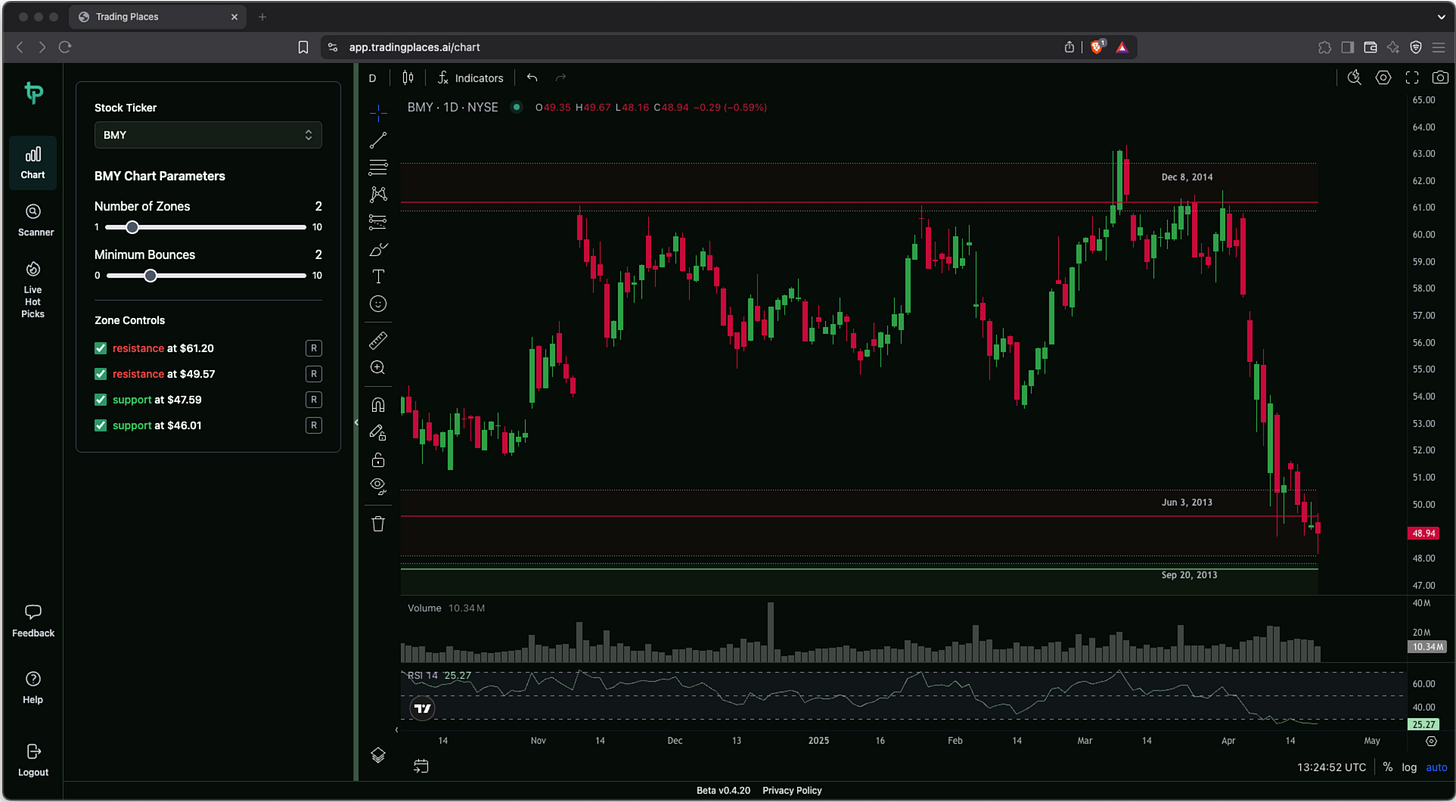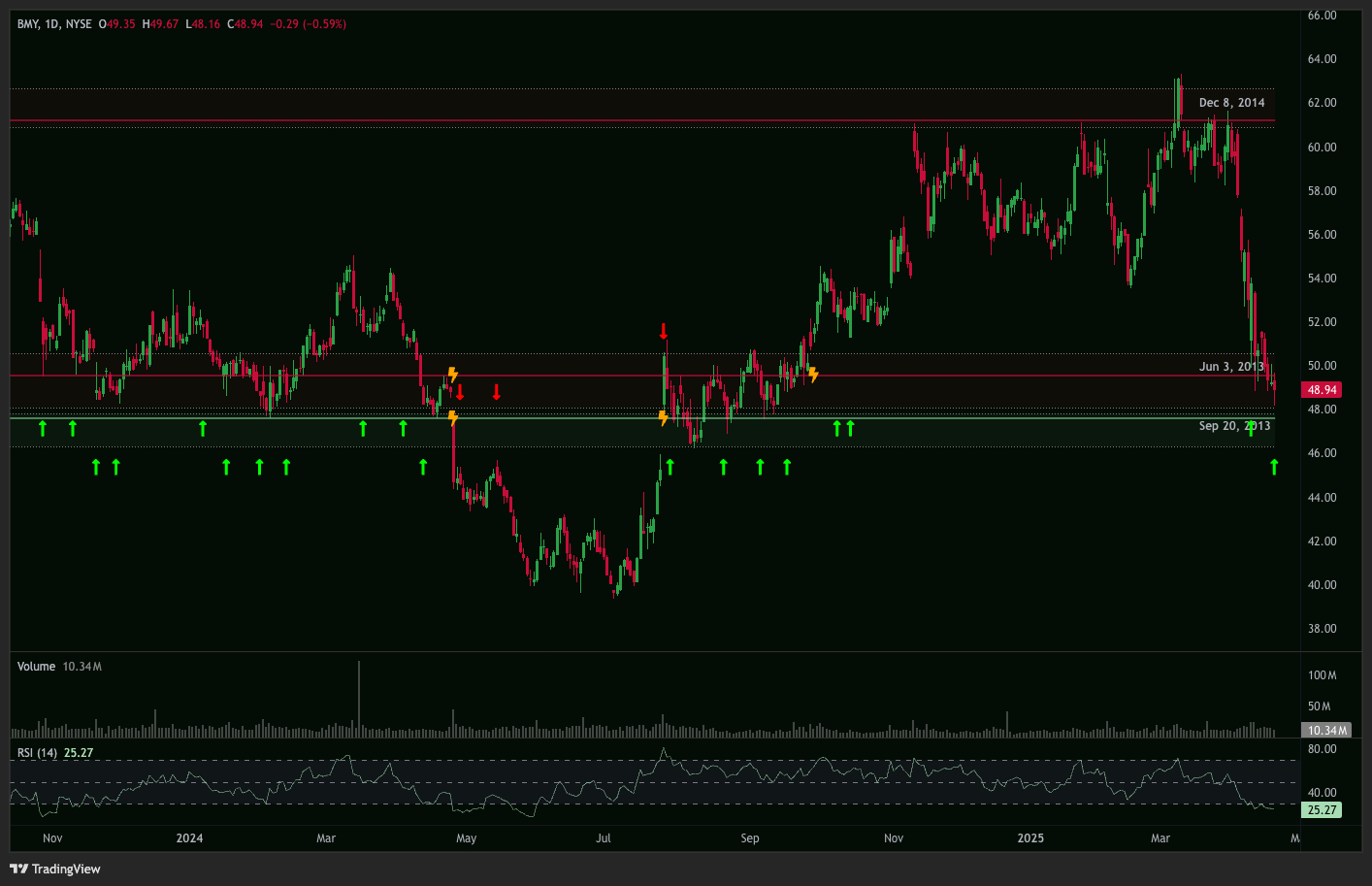Hot zone alert - April 22 2025
Your weekly guide to the the most promising trade setups in stocks, crypto, and currencies
Hey folks, welcome to another issue of Zone Alert!
First off, a big thank you to everyone who joined the beta launch of our online platform.
We’ve gotten some great feedback, and we’re working hard to build in as much of it as we can—keep ‘em coming!
But in case you haven’t signed up yet, good news: our beta invites are still open:
Now, onto what you actually came here for…
New here? Welcome to Zone Alerts.
This is where we highlight stocks that are approaching key support and resistance zones and analyze where the action might lead.
These weekly alerts help you zero in on high-potential setups while keeping risk management in check.
What’s in this issue:
• This week’s three new hot zones
• What are zones?
Here’s what our zone algo picked up for you this week:
Realty Income Corp. (O)
Real Estate • REIT - Retail • USA • NYSE
O was one of the more promising setups the Proximity Scanner had for us today.
The stock is back for another retest of its April 2016 resistance zone—its fourth attempt in just as many months.
While multiple retests can often weaken a zone and lead to a penetration—the declining volume in O’s most recent rally suggests otherwise. Buyers are not yet too convinced that a breakout is imminent.
This could mean that the zone might hold again, and another bounce is just around the corner.
This sets up a potential short opportunity. If it plays out, we’re targeting the November 2016 support—good for about 7.5% downside.
Burlington Stores Inc. (BURL)
Consumer Cyclical • Apparel Retail • USA • NYSE
Over the past couple months, BURL has been stuck between its January 2020 support and February 2020 resistance—consistently offering swings of around 8 to 15%.
But with volume and RSI not really giving anything away at the moment, it’s tough to tell where this stock is headed. So what now?
Actually, this is as straightforward as zone trades go.
Whether BURL bounces or penetrates, trading with zones can help maximize profits while still keeping risk in check.
A confirmed bounce off support could set up a long, with ~12% upside and only 4% downside risk.
While a confirmed break below support flips the setup into a short—also netting about ~12% and keeping downside risk around 4%
Either way, both setups offer a clean R/R ratio of 3:1. *chef’s kiss*
Bristol-Myers Squibb Co. (BMY)
Healthcare • Drug Manufacturers - General • USA • NYSE
BMY found itself down nearly 20% in less than a month after study data from their new heart drug turned out disappointing.
Right now, it’s hovering just a few ticks above a very strong September 2013 zone. This support has held up quite well against retests in August and September 2024.
Looking at RSI, it’s also of note that the stock has not been this oversold since June of last year.
If enough buyers see value at the $46-48 range and decide to step in, we could have a pretty solid rebound ahead of us.
If it materializes, we’re setting our first target at around $54 (the October 2013 zone)—around a 6% potential move.
WTF are Zones, anyway?
Zones are key price levels where the market has reacted strongly in the past—such as sharp reversals or sudden swings.
They’re areas where actual supply and demand met in the past, and likely will meet again.
“Why are these significant?”
Well, it all comes down to three key principles. We like to call them The Principles of:
When I Dip, You Dip, We Dip (aka psychology)
Traders are aware that others are watching these levels (zones) too. With everybody paying attention, this creates a self-fulfilling prophecy where everybody acts in anticipation of everybody else’s actions.
Markets Gonna Market ¯\_(ツ)_/¯ (aka technical factors)
If the first price rejection at the top of a zone was violent, it’s likely that buyers who entered at that level are now holding losses.
But with each retest, the rejection weakens, as there are fewer buyers remaining underwater. This weakens that resistance (or support for all you short-sellers), and could eventually lead to a break through.
Killer Whales (aka institutional plays)
Big players need liquidity in order to place massive orders without moving the market against themselves. So they wait for these zones, knowing a lot of us small fry (retail traders) will come to play.
This allows them to buy low or sell high without causing a lot of waves.
But remember: Zones are NOT guarantees but rather regions of increased probability for market moves. So always, ALWAYS use proper risk management.
Trading Places: Launch coming soon!
Stop obsessively refreshing your charts like it’s your ex’s Instagram.
By combining historical patterns with real-time market data, Trading Places identifies zones and assigns probabilities to each one—helping traders spot potential plays with higher chances of success.
It automates all of the curation, chart-plotting, and alerting for you, so you can actually have a life (or at least pretend to)!
Stay tuned!
Disclaimer: This isn't financial advice. This shouldn’t be news to you.










